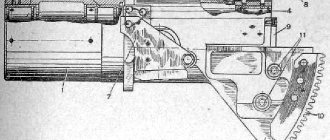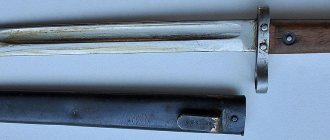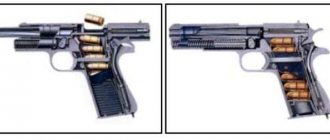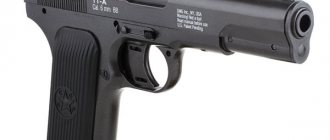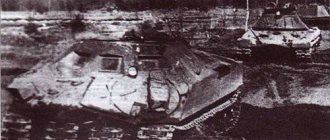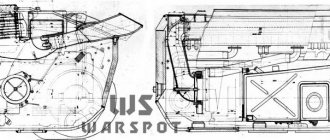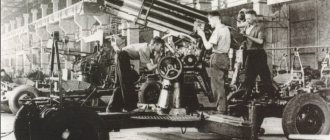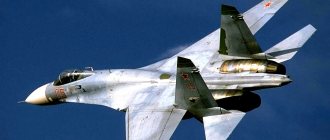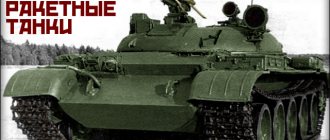In 1943, the tank units of the Wehrmacht possessed vehicles that, unlike in 1941, were not inferior to the tanks of the Red Army, and in some performance characteristics were superior to them. The appearance of the new Panzer kampfwagen VI Tiger and Panzer kampfwagen Panther finally confirmed the advantage of the Panzerwaffe.
In order to correct the situation and restore parity, it was necessary to radically change the T-34 medium tank, which had been in service since 1940. The T-34-85 became such a tank, capable of giving battle almost equally to any Wehrmacht tank.
The appearance of the T-34-85
Towards the development of more powerful art. systems began in January 1943. Five months later, the drawings of the new gun were ready, and in June the D-5T 85 mm guns were produced in metal. At the same time, other design bureaus were developing new artillery systems: S-53, S-50, LB-85.
In order to install a new gun in the T-34, it was necessary to make a new turret. Designing a tower with the installation of 85 mm art. The system was taken up by the design bureau, as well as the designer of plant No. 183. As a result, two cast tower designs were released.
This plant was given an order for the production of “thirty-fours” with an 85-mm artillery system.
In December 1943, the T-34 tank with an 85-mm artillery system under the designation T-34-85 was adopted by the Red Army. The main change in the modified vehicle was the installation of a new turret shape, with an extension of the turret shoulder strap.
With the advent of an enlarged turret, the main problem of the T-34-76 was eliminated, namely cramped conditions and the inability to add a fifth crew member. The D-5T artillery system with a caliber of 85 mm, developed at design bureau No. 9, was mounted in the turret.
Shells
The penetration of the s-53 at 126mm is very small. Therefore, in order to somehow improve the situation, we are purchasing golda. In patch 0.8.1, a function appeared for purchasing gold for silver (2800 silver for 1 piece!). Therefore, gold will be useful in the fight against levels 6-7. When you don't have enough penetration. But it's worth shooting for sure. Otherwise, you'll just go broke. But unfortunately, even gold cannot promise you constant penetration of level 7-8 tanks. Like this…
Tank design
There were 5 rollers on each side (dual type with external shock absorption with a diameter of 830 mm). The suspension on the car was individual, spring type. The rear wheels were driving; the engagement of the ridges on the tracks was carried out by rollers installed on them. The idler wheels were cast and had a crank mechanism to adjust the track tension. The mass of each caterpillar was 1150 kg, the width of the link was 550 mm. The number of steel tracks was 72 (36 ridged and 36 ridgeless).
The power plant of the vehicle was a 12-cylinder diesel engine V-2-34, producing a maximum power of 500 hp.
The fuel tanks held 545 liters of DT diesel fuel, two additional external fuel tanks were installed, the volume of which was 90 liters each, but these tanks were not connected to the engine power supply system. Two tubular radiators installed at an angle provided engine cooling.
Air purification was carried out by Cyclone air purifiers in the amount of 2 units. The engine was started using compressed air stored in 2 cylinders (located in the control compartment) or using an electric starter.
The transmission included main final clutches, a gearbox (with 5 gears), final drives and brakes. The electrical wiring is made according to a single-wire circuit (with voltage 12 and 24V). The tank uses the following electrical equipment: starter, turret rotation mechanism drive motor, ventilation systems, lighting, instrumentation, etc. Radio communication was provided using the 9-RS radio station (reception and transmission); internally, TPU-3bisF devices were used for crew communication.
Initially, the installation of the D-5T artillery system with a caliber of 85 mm with a coaxial DT machine gun with ammunition of 56 rounds for the main gun and 1953 machine gun cartridges was carried out. For guidance, a PTK-5 panorama and a telescopic articulated sight were used.
The turret housed a new commander's cupola with two opening hatch doors and equipped with an MK-4 periscopic all-round viewing device.
The armor protection of the hull did not change and amounted to: armor of the front of the hull 45 mm (the angle of inclination of the sheets: upper 60°, lower 53°), armor protection of the rear of the vehicle 45 mm (top 48°, bottom 45°), side armor was 45 mm at an angle of 40°, and armor protection roof was 20 mm. The hull itself was welded, made from sheets of rolled armor.
In 1943, attempts were made to increase the T-34's armor to 75 mm (T-43 version). The design bureau was faced with the question: how much could the mass of the tank be increased without affecting its maneuverability? Installing a new gun on the T-43 project greatly increased the weight of the tank, so the idea of increasing armor protection had to be abandoned.
The new turret of the T-34-85 tank had fairly good armor: the front of the turret had 90 mm of armor, the side armor was 75 mm, and the armor protection of the rear of the turret was 52 mm. The combat weight of the vehicle increased and amounted to 32 tons.
The crew of the T-34-85 tank consisted of 5 tankers. The location of the crew in the tank was as follows: the gunner (gun commander), commander and loader were in the turret, the driver and radio operator were in the vehicle body.
Crew skills
Before upgrading the crew's perks, you need to study the strengths and weaknesses of the tank. Recommended skills that need to be upgraded step by step for the crew:
| commander |
| gunner |
| driver mechanic |
| radio operator |
| charging |
First, you need to improve the stabilization of the gun using the “smooth turret rotation” and “smooth motion” skills. Since the tank has a radio operator, it is immediately recommended to study “radio interception”. This will greatly improve your visibility. In the future, you also need to upgrade the “eagle eye” of the commander. "Combat Brotherhood" will improve all crew characteristics by 5%. Next, it will be necessary to study “camouflage” and “repair” by the entire crew. Disguise will help in the game at the bottom of the list, and repairs will allow you to quickly restore damaged modules.
T-34-85 with ZIS-S-53 gun
At the beginning of 1944, the State Defense Committee adopted the T-34 with the ZIS-S-53 artillery system of 85 mm caliber. The reason for the abandonment of the D-5T gun was design flaws, for example, the lifting mechanism often failed. The first vehicles with the ZIS-S-53 cannon left the workshops in March 1944. The tank itself also underwent a number of design changes: com.
The turret was moved and installed in the area of the turret's stern, which made it easier for the crew members to position themselves, the radio station was removed from the hull and installed on the turret, and the PTK-5 was dismantled.
Also replaced with new Multicyclone air purifiers. Otherwise, the design has not undergone any changes. In 1945, the double-leaf hatch of the turret was replaced with a hatch with one opening flap.
Number of T-34-85 produced during the Great Patriotic War
| Tank modification | 1944, number of units. | 1945, number of units. | Total, number of units. |
| T-34-85 | 10499 | 12110 | 22609 |
| T-34-85 com. | 134 | 140 | 274 |
| T-34-85 OT | 30 | 301 | 331 |
| Total, number of units. | 10663 | 12551 | 23214 |
Advantages and disadvantages
| Advantages | Flaws |
| one-time damage | gun reload speed |
| tower reservation | viewing radius safety margin |
| gun stabilization | vertical declination angles |
| armor penetration with a basic projectile | |
| silver earnings |
Combat use
The first T-34s, armed with an 85 mm gun, began to be delivered to the armored units of the Red Army at the end of the winter of 1944. One of the first combat units equipped with the modernized T-34 was the 38th separate tank regiment. The towers were painted with inscriptions “Dimitri Donskoy”; they were made with funds provided by the Russian Orthodox Church. In total, the regiment consisted of 21 units; in addition to the T-34-85, the regiment consisted of flamethrower versions of the T-34-76.
As part of the 58th Army, the tank regiment conducted combat operations on the territory of Ukraine. Another unit equipped with new equipment with a D-5T cannon was the 119th Tank Regiment. Since the tank was made with money collected from the residents of the Republic of Armenia, inscriptions in the national language “David of Sassoun” were written on the tank turrets, in honor of the hero of the republic. The regiment took part in hostilities as part of the 2nd Ukrainian Front.
In the early spring of 1944, the modernized “thirty-fours” began to be sent to tank brigades, as well as to tank and mechanized corps. Thus, the 2nd, 6th, 10th and 11th Tank Corps received new equipment. When forming the crews of new vehicles, a problem arose in the presence of a 5th crew member. The issue was resolved by staffing the tank crews with soldiers from the anti-tank rifle company.
New vehicles were primarily supplied to the best combat formations of the Red Army.
At the same time, the crews were given only a few hours to master the new tanks. Widespread use of the T-34-85 occurred in battles in Right Bank Ukraine, especially during the crossing of the Dniester.
In clashes with enemy armored vehicles, the new equipment performed well, but was still inferior to heavy German tanks. The 88 mm guns of the Tigers had high armor-piercing power, especially since the armor protection of the hull of the T-34s did not change, and in terms of power, the 85 mm gun of the Soviet tank was slightly inferior to the German 88 mm.
Also, T-34s with the 85th D-5T artillery system in the amount of 23 units in the early spring of 1944 entered service with the 7th Separate Guards Red Banner and Order of the Red Star Novgorod Tank Brigade, which led the offensive as part of the Karelian Front. The brigade also included 42 T-34s with a 76 mm gun and 10 Valentine IXs.
The offensive was successful, especially since the enemy (Finnish and German combat formations) had practically no tank units. With the liberation of Kirkenes in Norway, the front was disbanded.
During the offensive Operation Bagration in the summer of 1944, T-34-85s occupied most of the Red Army's armored fleet. Thus, of the 811 T-34s participating in the offensive, vehicles armed with the 85 mm artillery system accounted for more than 50% of the tank fleet.
The largest number of new “thirty-fours” took part in the offensive operations of the Red Army in 1945. The 3rd TA of General P.S. Rybalko participating in the Vistula-Oder offensive operation. had on its staff 640 T-34-85 tanks, 22 T-34-76 tanks (used as minesweepers), as well as IS-2 heavy vehicles (21 units) and self-propelled artillery units (63 ISU-122 units, 63 units SU-85, 63 units SU-76 and 49 SU-57I).
In the battles for Berlin, the T-34-85 faced a very big problem, namely the widespread use of faust cartridges by the enemy.
Ease of production and use, as well as combat in urban conditions - all this made the Faustniks another dangerous opponent of Soviet tankers in the battles for the capital of the Reich.
In order to somehow protect their vehicles from shots from hand-held anti-tank grenade launchers, the crews hung various devices on their tanks. But, despite the active use of grenade launchers in battles, most of the T-34-85’s losses were caused by enemy artillery.
In the battles with Japan in the summer of 1945, 670 T-34-85 tanks took part, and along with them, the armored units of the Red Army operating against Japanese units included obsolete models T-26 and BT-7. The main striking force was the 6th Tank Army, its fleet consisted of 408 brand new T-34-85s, which arrived from two factories: No. 174 and No. 183.
A small number of "thirty-fours" were captured by German troops and their allies and were later used by them, for example by formations of the SS Wiking division. At the end of the war, T-34-85 also entered the armies of the USSR's allies (Poland, Yugoslavia, Czechoslovakia), and later to the countries that were part of the Warsaw Warsaw War.
T-34-85 in the post-war period
Production of the last serial "thirty-four" ended in 1946, and was replaced by a medium tank with the T-44 index. In the post-war period, the T-34-85 was still the main tank; it remained in this status until the 1950s. The T-44 was supplied to the troops in small quantities, and the production of the T-54 occurred at a very slow pace.
As the armored tank fleet of the USSR was updated, the T-34-85 passed into training status and was gradually removed from service, and, for example, the vehicles located in the training units of the Trans-Baikal and Far Eastern districts were used until the beginning of the 1970s.
After the end of the war, the T-34-85 took part in almost all military conflicts: in Korea, Vietnam, Kampuchea, the Middle East, Cuba, Afghanistan and others. The "thirty-four" also took part in military conflicts in Europe: the Hungarian uprising of 1956, military clashes between Turks and Cypriots on the island of Cyprus and the war in Yugoslavia in the 1990s.
The T-34-85 was in service with the ATS countries, a number of African countries, and was also in service in the states of Southeast Asia. Today, the “thirty-four” continue to carry out military service in several countries (Vietnam, Guinea, Yemen, North Korea, Laos, Cuba, etc.).
Performance characteristics of the T-34-85 tank and similar armored vehicles
Analogues of the “thirty-four” with 85 mm art. The system was the German “four” late modifications (Pz Kpfw IVH, J) and the American Sherman. At the same time, the powerful gun allowed the T-34-85 to fight heavier Wehrmacht armored vehicles than its competitors.
| Model | T-34-85 | PzKpfw IVJ | M4 Sherman (M4A1(76)W) |
| Weight, t | 32 | 25 | 30,3 |
| Length, mm | 5920 | 5920 | 5893 |
| Width, mm | 3000 | 2880 | 2616 |
| Height, mm | 2720 | 2680 | 2743 |
| Ground clearance, mm | 400 | 400 | 432 |
| Power, l/s | 500 | 272 | 395 |
| Maximum speed, km/h | 52 | 40 | 42 |
| Armor protection of the hull (forehead, sides, rear), mm | 45, 45, 45 | 80, 20, 30 | 51, 38, 38 |
| Armor protection of the turret (front, sides, rear), mm | 90, 52, 75 | 50, 30, 30 | 76, 51, 51 |
| Armament | 85 mm S-53, 2 machine guns | 75 mm KwK.40 L/48, 2 machine guns | 76.2 mm M-1 cannon, 3 machine guns |
| Projectile speed, m/s | 800 | 790 | 792 |
| Armor penetration (1500m), mm | 93 | 74 | 83 |
The T-34-85 in almost all characteristics was better than similar vehicles from both Germany and the Allied countries. Despite its greater mass, thanks to its more powerful engine, the T-34 was noticeably faster and more maneuverable than the American and German tanks. The Soviet tank was inferior only in the armor protection of the front of the hull.
The Soviet medium tank T-34-85 in many ways surpassed its predecessor, the T-34-76. Ease of manufacture and maintainability, ease of use and maneuverability - all this, coupled with good weapons, led to success on the battlefield and allowed it to become the most popular and one of the best tanks of the Second World War.
In addition, the high tactical and technical characteristics of the T-34-85 contributed to the use of the tank in many world military conflicts, in which it took part until the 90s of the 20th century.
Tactics
The tactics are very simple:
If we are at the top
We fan ourselves and shoot the enemy together with the team. Under no circumstances should you take on the flank alone. (They’ll sort it out and you won’t have time to blink.). Don't forget about shelters. On many maps we can use armor, especially at medium and long distances, receiving ricochets and not being penetrated by the enemy. You have to shoot with the S-53 only at full aim, otherwise you'll miss it. We are trying to break through together with TT, although we are sad with the dynamics. Various tricks if we are on city maps, such as playing from the gusli or forming a diamond. On open maps we try to place our foreheads on a slope, and only after the enemy ricochets do we climb out and shoot. It is also possible to play from the tower against level 5-6 TTs. In no case with Fri. In the top we feel good, even at ease. But you shouldn’t go to the middle of the field shouting “Olololoo!” They will salt it. And you won’t notice...
We're in the middle of the list
In the middle of the list, our main goal is to survive. Therefore, we behave carefully and cover the TT. We are looking for an ally with thick armor and going with him. He may be slow and have a not very powerful weapon, but together you can defeat almost any enemy. On any map, stick with your allies. Even if they are the most idiotic deer, they sit on defense on the city map. Your goal is to survive, but how is another question.
At the end of the list
There is no need to rip your hair out of your head or turn off your computer if you end up at the end of the list. Our main goal is to catch fireflies and disassemble them. We are also looking for the enemy’s weak equipment. We are trying to get to the art, preferably secretly. If you are noticed near the art then.. Game over. As in the middle of the list, we are looking for an ally with thick armor. It is this ally who will give you a chance at life, and if there is a chance at life, then victory is not far away as you think. No backhand shots. We get together to the fullest and achieve the highest results. Try to dismantle the main strength of the enemy. Shoot down the tracks, because this is also help.
